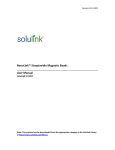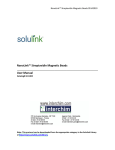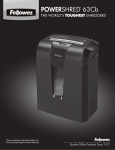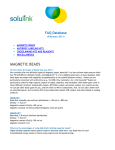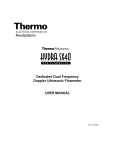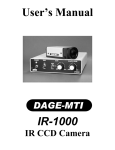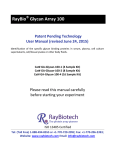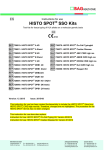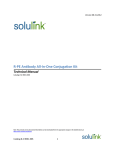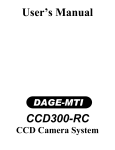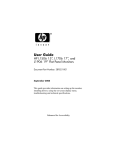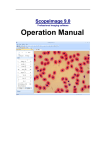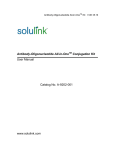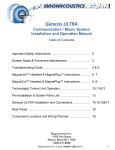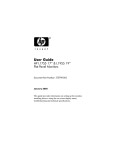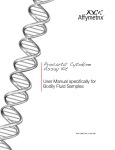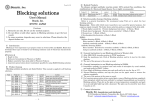Download MagnaLink™ Streptavidin Magnetic Beads User Manual
Transcript
Version 10.30.2012 MagnaLink™ Streptavidin Magnetic Beads _____________________________________________________ User Manual Catalog# M-1003 MagnaLinkTM Streptavidin Magnetic Beads User Manual 1.0 Product Description 3 2.0 Characteristics and Applications 4 3.0 Immobilization Protocol for Nucleic Acids 5 a. b. c. d. e. 3.1 MagnaLinkTM Bead Washing Procedure Immobilization of Biotinylated PCR Products Dissociation of Unbiotinylated Strand from Immobilized PCR Product Hybridization of Genomic DNA to MagnaLinkTM Immobilized DNA Nucleic Acid Binding, Blocking and Wash Buffers 8 Immobilization of Biotinylated Antibodies a. MagnaLinkTM Blocking Procedure b. Antibody Capture Procedure c. Antibody Binding, Blocking and Wash Buffers 2 5 6 7 8 9 9 9 10 1.0 Product Description MagnaLinkTM Streptavidin Magnetic beads are highly uniform, 2.8 micron-sized polymer-encapsulated (no exposed iron), super-paramagnetic beads containing covalently cross-linked streptavidin (Figure 1). MagnaLinkTM streptavidin magnetic beads are made by covalently cross-linking streptavidin to a hydrophilic surface using SoluLink’s proprietary HydraLink conjugation chemistry. The high surface area of these paramagnetic beads when combined with SoluLink’s efficient linking chemistry produces the most consistent and highest biotin binding capacity (≥10 nmol/mg) of any uniform streptavidin magnetic bead on the market. Beads are supplied at 1% solids (10 mg/mL) in nuclease-free water with 0.05% sodium azide. Figure 1. Scanning electron microscopy of MagnaLinkTM Streptavidin Magnetic beads. Features Highest free biotin binding capacity of any uniform bead (≥ 10 nmol/mg) Binds 0.8 nmol/mg biotinylated oligonucleotide Binds 0.75 nmol/mg biotinylated-IgG @ 4 biotins/IgG Beads are encapsulated (no exposed iron) Paramagnetic beads are highly uniform in size (2.8 + 0.2 microns) Fast magnetic response time (60% w/w magnetite) MagnaLinkTM Streptavidin Magnetic Bead Binding Capacity Ligand Free biotin Biotinylated oligo (23-mer) Biotinylated IgG (4 biotins per IgG) MagnaLink (2.8um) Binding Capacity Competitor's 2.8um Bead Binding Capacity ≥10 nmol/mg 0.65-0.90 nmol/mg ≥0.8 nmol/mg ≥0.75 nmol/mg NA 0.03-0.06 nmol/mg (112.6 ug/mg) (5-10 ug/mg) Table 1. MagnaLink™ Streptavidin Magnetic Beads binding capacity vs other competitive bead of similar size. 3 A cross-sectional diagram of MagnaLinkTM Streptavidin Magnetic beads is illustrated below. Covalently cross-linked streptavidin Outer core hydrophilic polymer surface Iron magnetite central layer Polystyrene core 2.0 Characteristics and Applications % Solids: MagnaLinkTM streptavidin magnetic beads are packaged nominally at 1% solids (10 mg/ml) as measured by their optical density at 600 nm versus a known size standard. Biotin Binding Capacity: The biotin binding capacity of these streptavidin magnetic beads is measured in nmol/mg. Biotin binding is quantitatively measured by incubating a known mass of beads (0.5 mg) with a fluorescein-biotin standard solution for 60 minutes and quantifying the amount of residual unbound fluorescein-biotin left in solution versus a negative control (non-streptavidin coated) bead. Cleaning: Surfactants are not added to this product and the particles are thoroughly washed with nuclease-free water containing 0.05% sodium azide prior to packaging. For most applications it is desirable to remove residual azide with a brief wash. Stability: Beads should always be kept stored at 2-8o C. Do not freeze. If beads are settled, resuspend by suitable methods including: vortexing, rotary mixing, swirling, shaking, or brief sonication. MagnaLinkTM streptavidin magnetic beads will remain stable when stored at 2-8oC for six months. Washing: MagnaLinkTM streptavidin magnetic beads are preferably washed by magnetic separation using any number of commercially available magnetic stands. Niobium magnetic stands are available in 50 ml, 15 ml, 1.5 ml, and 96-well plate formats from various vendors. The particle solution is placed on a magnetic stand for 2-3 minutes and the clarified supernatant is then carefully removed without disturbing the pellet. Re-suspension: After long-term storage and settling of particles, it is best to resuspend the particles thoroughly to avoid potential mild bead-to-bead aggregation. 4 MagnaLinkTM streptavidin magnetic beads possess the highest biotin-binding capacity of any commercially available polymer-encapsulated streptavidin particle. These beads are suited for high throughput robotic applications where high biotin loads must be immobilized and separated using a suitably strong magnet. The beads can be used to immobilize: Biotinylated antibodies and other proteins Biotinylated dsDNA (gDNA, PCR products) or biotinylated aRNA Biotinylated oligonucleotides The main advantage of using MagnaLinkTM in a given application is both their uniform bead size uniformity and their high biotin binding capacity. Higher binding capacities lead to cost savings and lower non-specific background (NSB). Applications include separation of biotin-labeled biomolecules including biotin-labeled antibodies, genomic DNA, RNA, PCR products, oligonucleotides (e.g. biotinylated oligo dT) or peptides. MagnaLinkTM streptavidin magnetic beads are also ideal for generating single-stranded PCR templates (by removal of the unbiotinylated competing PCR strand) to dramatically increase hybridization efficiency to complementary targets. MagnaLinkTM streptavidin magnetic beads are an affordable alternative for automated, high throughput immobilization processes using 96-well magnets to affect multiplex binding and separation of nucleic acid or immunoassay biomolecules 3. 0 Immobilization Protocol for Nucleic Acids To determine how much MagnaLinkTM streptavidin magnetic beads required for your specific application, please refer to Section 1.0. a. MagnaLinkTM Bead Washing Procedure 1. Before using, fully resuspend MagnaLinkTM streptavidin magnetic beads in their original container by vortex mixing. Mix vigorously for 1 minute to fully resuspend the beads. Pipette up and down if necessary to fully disperse the beads. 2. Transfer the desired volume of MagnaLinkTM streptavidin magnetic beads to a clean 1.5 ml tube. For example, 100 ug is sufficient to bind 60 pmol biotinylated oligonucleotide (23-mer) or 20 ug biotinylated PCR product (500 bp). Note- always use a suitable mass of beads to work with, for example 50 ug in a volume of 250 ul 1X Binding Buffer. Never use less than 10 ug since this quantity of beads is difficult to visualize and track in the tube. 5 3. Add sufficient Nucleic Acid Binding and Wash Buffer (see recipes) to bring the final volume to 0.25 ml, mix gently to resuspend and wash the beads. 4. Place the tube on a magnet for 2 minutes, discard the supernatant. 5. Remove the tube from the magnet and resuspend the beads in 0.25 ml of Nucleic Acid Binding and Wash Buffer. 6. MagnaLinkTM streptavidin beads are now ready for immobilization of biotinylated DNA. b. Immobilization of Biotinylated PCR Products 1. Determine the mass of MagnaLinkTM streptavidin magnetic beads required to bind a known mass of biotinylated PCR product and transfer this volume of beads to a 1.5 ml tube. Wash the beads as described in section a above. 2. Add a volume (5-50 ul) of *purified PCR product in water or 1XT10E1 (free of excess biotinylated primers) to 0.25 ml of washed beads in Nucleic Acid Binding and Wash Buffer. Note-the presence of biotinylated primers will compete with biotinylated PCR product for binding to the bead and therefore primers must be removed unless using an excess of bead binding capacity. 3. Vortex to mix the beads. 4. Incubate for 30 minutes at room temperature preferably on a platform shaker (e.g. Titer-Tek Platform shaker, Lab-Line Instruments, at a setting of 5 so as to keep the beads fully resuspended during the binding process). For maximum capture efficiency do not allow the beads to settle during binding. Note-For biotinylated oligonucleotides and DNA fragments smaller than 1 kb 30 minutes is a suitable period. For larger fragments (e.g. >5 kb), capture at 40oC for 60 minutes may be required. Inefficient biotinylation of the PCR product or the presence of excess, free biotinylated primers will lead to reduced capture efficiency. For certain applications, MagnaLinkTM can be pre-blocked with Nucleic Acid Binding and Wash Buffer containing 100 ug/ml denatured herring or salmon sperm DNA to reduce non-specific interactions. 5. After immobilization, place the tube on a magnet for 2 minutes then carefully remove the supernatant. In certain high DNA loading applications, the optical density of the supernatant can be used to quantify the amount of unbound DNA 6 remaining (1 absorbance unit dsDNA = 50 ug/ml/OD260 for double-stranded DNA or 33 ug/ml/OD260 for ssDNA) Note-take care not to disrupt the pellet on the sides of the vessel during wash and aspiration steps. 6. Wash the immobilized PCR product by adding 0.25 ml Nucleic Acid Binding and Wash Buffer. Mix the solution by pipetting up and down to disperse the beads fully. Place back on the magnet for 2 minutes and remove the clarified supernatant. 7. Wash the beads two additional times with the aid of the magnetic stand and discard wash solutions. Make sure all remaining supernatant is removed and do not allow the beads to dry. Immediately proceed to the next section. c. Dissociation of Unbiotinylated Strand from Immobilized PCR Product 1. Immediately after step 7 (see above), resuspend the DNA-coated MagnaLinkTM beads in exactly 50 µl of freshly prepared 100 mM NaOH. Note- Prepare daily from a 10N NaOH stock solution using molecular grade water. 2. Incubate the beads in 100 mM NaOH at room temperature for 1 minute. 3. Place the tube back on the magnetic stand for an additional minute and transfer the supernatant to a new 1.5 ml tube. This supernatant contains the nonbiotinylated DNA strand. 4. Neutralize the non-biotinylated strand by addition of 10 ul 1 M MES buffer pH 3.0. Confirm the pH of the neutralized solution by spotting 1 ul on 0-14 pH paper. After neutralization store the solution at 4oC for later use. Note-If necessary add small incremental volumes (e.g. 0.5 ul) of 1M MES buffer can be added to adjust the final pH of the DNA solution to neutrality. Always confirm neutrality using a 1 ul aliquot of the neutralized sample on colored pH paper. 5. With the aid of a magnetic stand, immediately, wash the MagnaLinkTM beads containing the immobilized biotinylated strand 3 times using 250 ul Nucleic Acid Binding and Wash Buffer (50 mM Tris-HCl, 150 mM NaCl, 0.5% Tween-20, pH 8). Mix the beads between washes by pipetting up and down to disperse. Discard supernatants between washes. 7 6. Resuspend the MagnaLinkTM beads with the immobilized biotinylated strand in 250 ul Nucleic Acid Binding and Wash Buffer. Leave the beads in this solution until they are ready for down-stream applications. d. Hybridization of Genomic DNA to MagnaLinkTM Immobilized DNA 1. Place MagnaLinkTM beads containing the immobilized biotinylated strand on a magnetic stand for 2 minutes and carefully remove the supernatant. 2. Wash beads once with 250 ul of pre-hybridization buffer and remove the supernatant. 3. Add a volume of pre-hybridization solution (50-100 ul) containing previously heat denatured carrier DNA (at 100 ug/ml) to the beads and incubate on a heated platform shaker (e.g. Eppendorf 5436 Thermo-mixer) at 45oC for 2 hours. 4. After pre-hybridization, remove the solution using a magnetic stand and add the desired hybridization solution containing heat denatured genomic DNA. 5. Vortex the bead mixture, and place the tube back on a heated platform shaker to allow hybridization to proceed (several hours to overnight). 6. Place the beads on a magnetic stand for 2 minutes to remove the hybridization solution. 7. Wash the beads with 250 ul of stringency wash buffer I using a Thermo-mixer at 45o C for 5 minutes. 8. Place the beads back on the magnetic stand for 2 minutes, discard the supernatant. . 9. Repeat step 7 and 8 using stringency wash buffer II, discard the final supernatant. 10. Release hybridized genomic DNA by heating the beads in 50-100 ul molecular grade water at 95o C for 5 minutes. Note-Never reuse the beads after this heat step. e. Nucleic Acid Binding, Blocking and Wash Buffers Nucleic Acid Binding and Wash Buffer 50 mM Tris-HCl, 150 mM NaCl, 0.05% Tween 20, pH 8.0 8 Nucleic Acid Binding and Wash Buffer w/Carrier DNA 50 mM Tris-HCl, 150 mM NaCl, 100 ug/ml denatured herring sperm DNA, 0.05% Tween-20, pH 8.0 Note-some applications require pre-blocking beads using carrier DNA Pre-Hybridization Buffer 3X SSC + 0.05% Tween 20, 100 ug/ml denatured herring sperm DNA (20X SSC = 3M NaCl, 0.3 M Na citrate, pH 7.0) Hybridization Buffer 3X SSC + 0.05% Tween 20 Stringency Wash Buffers Stringency Wash Buffer I - 2X SSC + 0.05% Tween 20 Stringency Wash Buffer II - 0.5 X SSC + 0.05% Tween 20 3.10 Immobilization of Biotinylated Antibodies a. MagnaLinkTM Blocking Procedure (1 mg beads) 1. Transfer 100 ul of MagnaLinkTM streptavidin magnetic beads @ 10 mg/ml to a new 1.5 ml microfuge tube. 2. Place the tube on a magnetic stand for 2 minutes, carefully remove and discard the supernatant. 3. Add 1 mL of Antibody Blocking Solution (filtered) to the beads to resuspend. 4. Place the tube on a platform shaker (e.g. LabLine Titer-TeK @ setting of 5) for 30 minutes to block the beads. 5. Place the tube on a magnetic stand for 2 minutes and completely remove the blocking solution. 6. Using a magnetic stand, wash the blocked beads 4 times with 1 ml 1X Antibody Binding and Wash Buffer (50 mM Tris-HCl, 150 M NaCl, 0.05% Tween 20, pH 8.0). Discard the wash solution between washes. 7. After the final wash, resuspend the blocked beads at 10 mg/ml using 100 ul 2X Antibody Binding and Wash Buffer. 8. Beads are now ready for capture and immobilization of biotinylated antibody (Refer to section 3.1 b). 9 b. Antibody Capture Procedure 1. Refer to Section 1 to determine the mass of blocked MagnaLinkTM streptavidin magnetic beads required to capture and immobilize a given quantity of biotinylated-IgG. Note-For example, 1 milligram of pre-blocked MagnaLinkTM streptavidin magnetic beads will quantitatively bind 75 ug of biotinylated IgG at a biotin molar substitution ratio of 3 (i.e. 3 biotins/antibody) in 60 minutes on a platform shaker. 2. Place the tube containing the desired quantity of pre-blocked beads on the magnet stand for 2 min. and carefully remove the supernatant. 3. Wash the beads once with 0.25 ml of 1X Antibody Binding and Wash Buffer. 4. Place the tube containing the beads on a magnet stand for 2 min. and carefully remove the supernatant 5. Add 0.125 ml of 2X Antibody Binding and Wash Buffer and 0.125 ml of biotinylated IgG containing sample to the beads. 6. Mix the beads well, and incubate the tube on a platform shaker (e.g. Titer-Tek Platform shaker, Lab-Line Instruments, setting of 5) at room temperature for 60 minutes to capture the biotinylated antibody. 7. Place the tube containing the immobilized antibody on a magnetic stand for 2 min. and carefully remove the supernatant. 8. Wash the bead pellet twice using 0.25 ml 1X Antibody Binding and Wash Buffer. 9. The immobilized biotinylated IgG is now ready for other downstream applications. c. Antibody Binding, Blocking and Wash Buffers 1X Antibody Binding and Wash Buffer 50 mM Tris-HCl, 150 mM NaCl, 0.05% Tween 20, pH 8.0 2X Antibody Binding and Wash Buffer 100 mM Tris-HCl, 300 mM NaCl, 0.1% Tween 20, pH 8.0 10 Antibody Blocking Buffer BlockerTM Casein in TBS (Trademark of Pierce Chemical, Cat. # 37532) Filter the casein block solution through a 0.45 µ filter before using. Note- use only Hammersten-grade casein for blocking streptavidin beads since other sources of casein will contain endogenous biotin. 11











